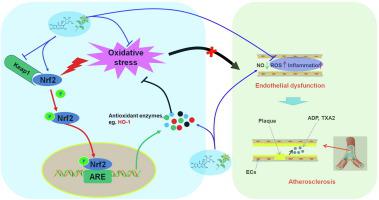Journal of Advanced Research ( IF 10.7 ) Pub Date : 2021-07-06 , DOI: 10.1016/j.jare.2021.06.023 Qing Zhang 1 , Jia Liu 1 , Huxinyue Duan 1 , Ruolan Li 1 , Wei Peng 1 , Chunjie Wu 1

|
Introduction
Recently, Nrf2/HO-1 has received extensive attention as the main regulatory pathway of intracellular defense against oxidative stress and is considered an ideal target for alleviating endothelial cell (EC) injury.
Objectives
This paper aimed to summarized the natural monomers/extracts that potentially exert protective effects against oxidative stress in ECs.
Methods
A literature search was carried out regarding our topic with the keywords of “atherosclerosis” or “Nrf2/HO-1” or “vascular endothelial cells” or “oxidative stress” or “Herbal medicine” or “natural products” or “natural extracts” or “natural compounds” or “traditional Chinese medicines” based on classic books of herbal medicine and scientific databases including Pubmed, SciFinder, Scopus, the Web of Science, GoogleScholar, BaiduScholar, and others. Then, we analyzed the possible molecular mechanisms for different types of natural compounds in the treatment of atherosclerosis via the protection of vascular endothelial cells from oxidative stress. In addition, perspectives for possible future studies are discussed.
Results
These agents with protective effects against oxidative stress in ECs mainly include phenylpropanoids, flavonoids, terpenoids, and alkaloids. Most of these agents alleviate cell apoptosis in ECs due to oxidative stress, and the mechanisms are related to Nrf2/HO-1 signaling activation. However, despite continued progress in research on various aspects of natural agents exerting protective effects against EC injury by activating Nrf2/HO-1 signaling, the development of new drugs for the treatment of atherosclerosis (AS) and other CVDs based on these agents will require more detailed preclinical and clinical studies.
Conclusion
Our present paper provides updated information of natural agents with protective activities on ECs against oxidative stress by activating Nrf2/HO-1. We hope this review will provide some directions for the further development of novel candidate drugs from natural agents for the treatment of AS and other CVDs.
中文翻译:

Nrf2/HO-1信号的激活:中草药通过保护血管内皮细胞免受氧化应激治疗动脉粥样硬化的重要分子机制
介绍
近年来,Nrf2/HO-1作为细胞内抗氧化应激的主要调节途径受到广泛关注,被认为是减轻内皮细胞(EC)损伤的理想靶点。
目标
本文旨在总结可能对 ECs 中的氧化应激发挥保护作用的天然单体/提取物。
方法
以“动脉粥样硬化”或“Nrf2/HO-1”或“血管内皮细胞”或“氧化应激”或“草药”或“天然产物”或“天然提取物”为关键词对我们的主题进行了文献检索或基于草药经典书籍和科学数据库的“天然化合物”或“中药”,包括 Pubmed、SciFinder、Scopus、Web of Science、GoogleScholar、BaiduScholar 等。然后,我们分析了不同类型的天然化合物通过保护血管内皮细胞免受氧化应激来治疗动脉粥样硬化的可能分子机制。此外,还讨论了可能的未来研究的前景。
结果
这些对内皮细胞氧化应激具有保护作用的药物主要包括苯丙烷类、黄酮类、萜类和生物碱类。这些药物中的大多数可缓解由于氧化应激引起的 ECs 细胞凋亡,其机制与 Nrf2/HO-1 信号激活有关。然而,尽管通过激活 Nrf2/HO-1 信号传导对 EC 损伤发挥保护作用的天然药物的各个方面的研究不断取得进展,但基于这些药物开发治疗动脉粥样硬化 (AS) 和其他 CVD 的新药仍需要更详细的临床前和临床研究。
结论
我们目前的论文提供了通过激活 Nrf2/HO-1 对 ECs 抗氧化应激具有保护活性的天然药物的最新信息。我们希望这篇综述能为进一步开发用于治疗 AS 和其他 CVD 的天然药物的新型候选药物提供一些方向。

























 京公网安备 11010802027423号
京公网安备 11010802027423号